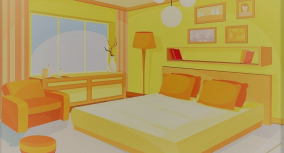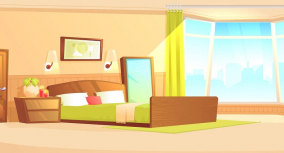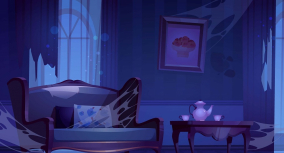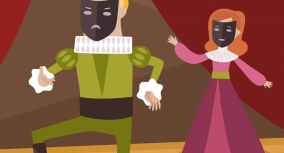“The Yellow Wallpaper” summary is as follows: a woman is confined to her room as a “rest cure” for postpartum depression. Obsessing over the room’s yellow wallpaper, she descends into madness. The journey she goes through symbolizes her struggle against societal and marital oppression, which is the central element of “The Yellow Wallpaper” meaning.
The experts at Custom-Writing.org have prepared this page to explain in detail what the short story “The Yellow Wallpaper” is about. Read on and learn all about this tale of isolation and control and its nuanced symbolism – and make sure to check out the plot diagram that visually represents “The Yellow Wallpaper” synopsis.
❓ The Yellow Wallpaper Synopsis: What Happens in the Story?
The main focus of “The Yellow Wallpaper” by Charlotte Perkins Gilman is on mental health. The story is written from the main character’s point of view, in the form of her diary entries. This woman, called Jane (although we don’t see her name much), has been prescribed plenty of rest and fresh air, the “rest cure”, to treat her nervous disposition. However, after being confined to one room for most of the day and night, she becomes obsessed with the room’s yellow wallpaper, and it begins to drive her crazy.
📊 The Yellow Wallpaper: Analysis of the Story’s Plot
Below you’ll find an infographic that describes the main events of “The Yellow Wallpaper” by Charlotte Perkins Gilman. It alone can become the main idea generator for when you need to write a paper about this story.
The plot of “The Yellow Wallpaper” is a classic example of a narrative that follows the pattern of rising action, climax, falling action, and resolution.
- The introduction sets the stage and presents the protagonist, a young woman suffering from a nervous condition.
- The rising action begins as the woman and her husband move into a secluded estate for the summer, where she becomes fixated on the yellow wallpaper in their bedroom.
- The climax of the story occurs when the protagonist tears the wallpaper off the wall in a state of delirium. She does it in an attempt to free the person she believes is trapped inside.
- The falling action sees the woman’s husband discovering her in her manic state.
- The resolution follows, where the protagonist completely loses her grip on reality.
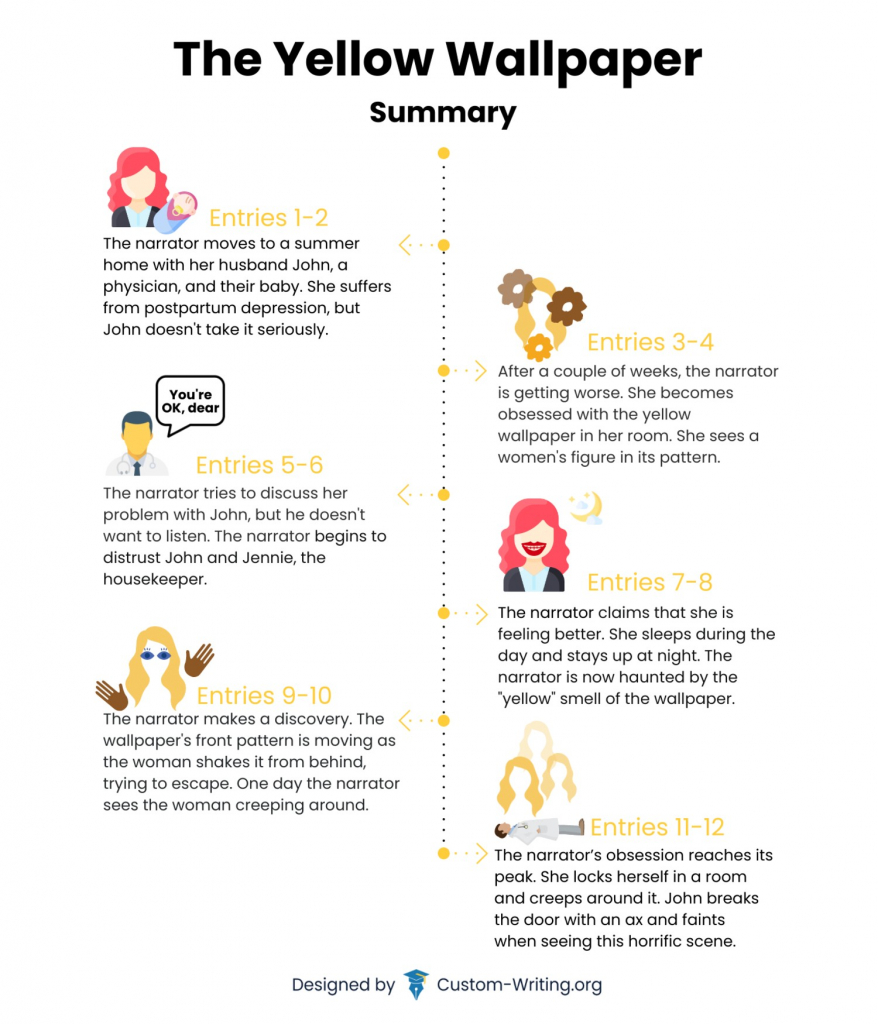
📝 The Yellow Wallpaper Short Summary
🔍 Detailed Summary of The Yellow Wallpaper
Entries 1-3
The first few diary entries are crucial in describing the setting and its influence on the narrator’s state. Jane’s husband, John, is a doctor and the one who decided that Jane needed the “rest cure.” Although Jane believes she is seriously sick, John says she is wrong. This is why he rented the house, which Jane’s diary entries describe as a beautiful Victorian style summer estate. She wanders about the grounds wondering how they can possibly afford it.
Jane is apparently suffering from postpartum depression. John, in his turn, denies her state and says that she has only a slight disorder. However, she is not allowed to undertake any intellectual work. Feeling powerless and unable to protest, she hides her diary.
Personally, I believe that congenial work, with excitement and change, would do me good. But what is one to do? I did write for a while in spite of them; but it does exhaust me a good deal—having to be so sly about it, or else meet with heavy opposition.
The Yellow Wallpaper, Narrator
It seems like the writing helps the narrator “relieve her mind,” so she writes about the house. It looks kind of weird to her, and she particularly doesn’t like the room John picked. The place was empty for quite a while, and she even jokes that the house is haunted. John only laughs at her, and she writes that this is something she could have expected from the marriage. Moreover, he seems to be controlling a lot of her life. As a result, she becomes more confident in hiding the journal from him.
One room in the house does please her, though. It is the airy one at the top of the house with bars on the windows. It would be great as a nursery. The only thing that repels and irritates her about the room is the yellow wallpaper.
After a couple of weeks, the woman feels much worse. Her husband is away, and her baby is with the nanny. She spends most of her time alone in the nursery. It only has one piece of furniture, the bed. This means it is not much for her to look at apart from the wallpaper. She writes about how much she hates it.
I never saw a worse paper in my life.
The Yellow Wallpaper, Narrator
At one point, the narrator describes looking at the garden through the barred window and imagining that people are walking out there. John disapproves of this behavior, though. He even forbids her to have any guests. Once again, the focus shifts to the wallpaper. Now, her imagination draws some expressions on it.
At this time, John’s sister, Jennie, approaches the house. She has been helping with housekeeping there. The narrator’s worrisome and distracted state is noticeable now, as her attention shifts back and forth from the wallpaper to the surroundings. This time, she writes that she can see a mysterious, subtle figure in the wallpaper’s pattern.
After celebrating the Fourth of July with some family members, the narrator is left alone again. She feels more depressed and spends a lot of time crying. John wants to send her to Dr. Weir Mitchell if she is not feeling better by the fall.
As her husband is away, she usually spends her time in the garden or stares at the wallpaper. It seems like she is determined to find the rhythm in that random pattern. In the different lights, it changes and reveals some new details. Her obsession with the wallpaper grows every day.
Entries 4-6
As she gets weaker and weaker, John is concerned that her imagination is taking over. The narrator quits attempts to attract John and Jennie’s attention to the yellow wallpaper. In summary, she is utterly obsessed with just watching the pattern. The figure that was previously described as subtle is now evident to her. Her diary entry describes it as the shape of a woman who is bending down.
She tries to talk about it to John again, but without any success. She also wishes to leave the house, but he has complete control over her. That night she lays on the bed awake, staring at the wallpaper. In the changing angles of the moonlight, it seems like the figure on the wallpaper moves. She even gets up to check and feel it, which proves her right.
“Bless her little heart!” said he with a big hug; “she shall be as sick as she pleases! But now let’s improve the shining hours by going to sleep, and talk about it in the morning!”
The Yellow Wallpaper, John
The next entry says that Jane tried to talk to John again, to persuade him that they should leave the house, but he gets even stricter with her. He says they can’t leave the house now, as there are only three weeks of rent left. Moreover, he sees her health improving. The narrator argues that only her physical health gets better while her mental health suffers. Then, John switches his tone to a very harsh one, almost commanding her to cut off that nonsense of hers.
Jane finds even more significance in the pattern within the yellow wallpaper. It confronts her, “like a bad dream”. However, now she understands that its changes are due to the light.
But there is something else about that paper—the smell! I noticed it the moment we came into the room, but with so much air and sun it was not bad. Now we have had a week of fog and rain, and whether the windows are open or not, the smell is here. It creeps all over the house.
The Yellow Wallpaper, Narrator
The narrator continues to spend more and more time inside the house. John encourages this and even insists on her lying down for an hour after every meal. His increasingly controlling behavior makes her scared of him sometimes. Her diary entries show that she no longer trusts him or Jennie. One day, she catches Jennie touching the wall, which she sees as competition in studying the wallpaper. However, Jennie is just interested in how the narrator got yellow stains on her clothing (probably from rubbing against the wallpaper).
Entries 7-9
The summary of The Yellow Wallpaper’s 7th entry is quite shot. Jane seems to be getting better, and her diary entries indicate that her mood is improving. She believes that this is due to the wallpaper. However, she is reluctant to share that with her husband.
I’m feeling ever so much better! I don’t sleep much at night, for it is so interesting to watch developments; but I sleep a good deal in the daytime. In the daytime it is tiresome and perplexing.
The Yellow Wallpaper, Narrator
The secrets of the wallpaper are the only thing that she is concerned about now. She knows that they only have one more week at that house, and she is sure she can crack them at that time. She starts sleeping during the day and watching the changes in the wallpaper pattern during the night. She is interested, even obsessed, with the wallpaper. It still disturbs her. She writes that she especially dislikes the yellow color and, more disturbingly, describes “a yellow smell” of it. She can even smell it outside the house!
She confesses to thoughts of burning down the house. She seems to get used to the smell eventually, but then she notices a long streak on the yellow wallpaper. It looks like someone has been rubbing it again and again, and Jane wonders who did.
Then, there is quite a horrifying development in the wallpaper pattern. The mysterious figure, which appeared faintly before, now crawls around and causes the wallpaper to shake. The diary entry describes the figure trying to get through the bars created on the wallpaper by the shadow from the window. However, it can’t break through the pattern.
I see her on that long shaded lane, creeping up and down. I see her in those dark grape arbors, creeping all around the garden. I see her on that long road under the trees, creeping along, and when a carriage comes she hides under the blackberry vines.
The Yellow Wallpaper, Narrator
Entries 10-12
Next, Jane writes that the woman’s figure from the wallpaper manages to escape the barrier during the day. She is convinced that it is that mysterious lady because no other self-respecting woman would be creeping around in the daylight. She is trying to keep it a secret, though. Whenever the figure escapes, the narrator locks the room’s door so that John won’t know anything. At night, she wants him to leave, so she is alone with the figure from the wallpaper.
Just like before, the next events in “The Yellow Wallpaper” summary follow the diary entries. However, the narrator hides a lot of stuff from the reader due to her paranoia.
The narrator wants to tear down a part of the wallpaper to see what is hiding behind the pattern. At the same time, there is a discovery she doesn’t want to share with the readers. Her issues with trust are getting worse.
I have found out another funny thing, but I shan’t tell it this time! It does not do to trust people too much.
The Yellow Wallpaper, Narrator
John is worried about her and talks to Jennie about it. However, Jane has lost all confidence in them and thinks that his seemingly loving care is fake. She secretly blames the wallpaper for John and Jennie’s behavior.
The last entry concerns their last day in the house. Again, Jane wants to stay alone in the room at night. As soon as the moon comes out, she starts peeling away strips of the yellow wallpaper to help the mysterious figure escape.
A strip about as high as my head and half around the room. And then when the sun came and that awful pattern began to laugh at me I declared I would finish it to-day!
The Yellow Wallpaper, Narrator
The next day, Jennie finds it, but the narrator merrily says she did it out of pure hate for the wallpaper pattern. Jennie seems to take this as a joke because she laughs and asks her not to get overwhelmed. However, the task must be finished. All the wallpaper must be removed. The narrator’s obsession peaks as she refuses to leave the room, even as all their belongings are being taken out. Eventually, everything is removed from there, except for the bed.
Once she is alone in the room again, she locks herself in there. She throws the keys out the window and returns to the job at hand. The narrator tries to reach the wallpaper’s top, but the bed is too heavy for her to move. Filled with frustration, she starts biting the paper. “The yellow wallpaper” seemed to be laughing at her desperate attempts. However, she keeps on removing everything she can reach. She gets so angry that she would jump out of the window if there were no bars to stop her. She says, however, that such an act would be considered inappropriate.
Here, the themes and the structure of the story remain the same, but the perspective shifts. It seems as though the narrator is no longer speaking as Jane but as the woman from the wallpaper. She has escaped. She doesn’t want to do anything else but creep along the wall. She roams the perimeter of the room, rubbing against the wall and feeling the perfect fit of her shoulder in the groove of the wall. Leaving the room and going anywhere else seems unacceptable to her.
As John returns, he tries to get in but finds that the door is locked. He panics and asks for an ax to break the door. The woman says that the keys are just outside. She keeps repeating it again and again until he comes into the room. In the end, the woman pronounces that she is finally free, despite John “and Jane.” She doesn’t want to go back. John faints from seeing this horrific scene, but the narrator keeps creeping around the room along the wall, stepping over his body every time she passes him.
“I’ve got out at last,” said I, “in spite of you and Jane! And I’ve pulled off most of the paper, so you can’t put me back!” Now why should that man have fainted? But he did, and right across my path by the wall, so that I had to creep over him every time!
The Yellow Wallpaper, Narrator
We hope that the above summary of “The Yellow Wallpaper” is useful. If you want to be fully aware of the true meaning of the story, you should check out both “The Yellow Wallpaper” summary and analysis. And if you’re looking for exciting essay ideas on the story, please read our list of essay topics.
